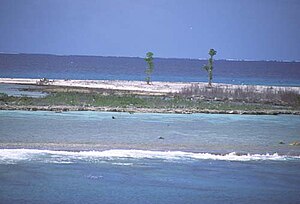Maupihaa
| Maupihaa | ||
|---|---|---|
| Astronaut photo by Maupihaa | ||
| Waters | Pacific Ocean | |
| archipelago | Society Islands | |
| Geographical location | 16 ° 48 ′ S , 153 ° 57 ′ W | |
|
|
||
| Number of islands | 4th | |
| Main island | Motu Maupihaa | |
| Land area | 2.6 km² | |
| Lagoon area | 30 km² | |
| Residents | 9 | |
| One of the motus of Maupihaa | ||
Maupihaa (also known as Mopihaa or Mopelia ) is an atoll of the Society Islands in the Pacific Ocean . It is the southernmost atoll of the " Leeward Islands ".
Politically, Maupihaa belongs to the French Overseas Zealand ( Pays d'outre-mer - POM) French Polynesia and is thus affiliated to the EU . The island is administered by a subdivision ( Subdivision administrative des Îles Sous-le-vent ) of the High Commission of French Polynesia ( Haut-commissariat de la République en Polynésie française ) based in Papeete . Maupihaa belongs to the municipality of Maupiti ( Commune de Maupiti ).
geography
The atoll has a diameter of about 8 km and a land area of about 2.6 km². The up to 40 m deep lagoon is almost completely surrounded by a fringing reef on which several motus lie. The atoll is not permanently inhabited (as of 2008), but on the long Motu Maupihaa in the east of the atoll there are still some buildings that are temporarily used for copra harvest , the remains of a small village that in 1985 still had 10 inhabitants. The 2007 census shows 9 residents, 4 of them women.
history
The atoll was discovered for Europe in 1767 by the British Samuel Wallis .
During the First World War , on August 2, 1917, the German auxiliary cruiser SMS Seeadler of the "sea devil" Felix Graf von Luckner stranded on the fringing reef of Maupihaa. At that time there were only three Polynesians living on the island who collected coconuts for a society in Tahiti and processed them into copra. 64 crew members of the sea eagles and 47 prisoners - crews and passengers of the previously captured ships - lived peacefully with the Polynesians for several months on Maupihaa. Luckner proclaimed the foundation of the "last German colony" - Cäcilieninsel - without authorization . The crew built the Seeadlerdorf settlement from the remains of the stranded ship .
Luckner immediately had the dinghy repaired and sailed with some crew members for 22 days to the Fiji islands. He planned to hijack a ship there, return to Maupihaa and save the rest of the crew. However , he was captured on the small Fiji island of Katafanga .
The Germans who stayed behind managed to capture the copra schooner Lutèce . They renamed him Fortuna , left the prisoners of war - provided they had sufficient supplies - back on Maupihaa and sailed to Easter Island , where the ship drifted onto the cliffs and sank in the strong surf. After the team had spent four months on Easter Island, they were shipped to neutral Chile and arrested there until the end of the war.
The booty from Luckner's pirate expeditions in the Pacific is said to be buried on Maupihaa today.
Individual evidence
- ^ Society Islands - Maupihaa ( Memento from December 23, 2010 in the Internet Archive ) on oceandots.com (Eng.)
- ↑ Living Archipelagos - Mopelia Atoll ( Memento of September 28, 2007 in the Internet Archive ) (Eng.)
- ↑ Archived copy ( Memento from February 22, 2011 in the Internet Archive )
- ↑ Ralf Bernd Herden : Flying sheets of history. Volume 4/2008 of the discussion papers of the University of Public Administration Kehl, Books on Demand, Norderstedt 2009, ISBN 978-3-837-04991-6 , p. 71.
- ^ F. Graf von Luckner: Seeteufels Weltfahrt , Gütersloh 1956
- ↑ G. Seuren and S. Heufelder: Schatzsucher , Bergisch Gladbach 1993
literature
- M.-H. Sachet: Natural History of Mopelia Atoll, Society Islands. Atoll Research Bulletin No. 274, December 1983 (with map and detailed description; PDF; 2.5 MB)


